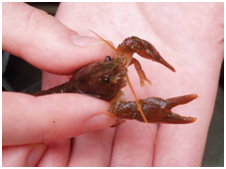A large population of American signal crayfish have been confirmed in the River Blyth – a blow for the internationally important population of native white-clawed crayfish on the neighbouring River Wansbeck.
 To safeguard our native crayfish, anglers and other river users are being urged to stop the spread of the signal crayfish, and the plague it carries, by following three simple steps: Check, Clean and Dry.
To safeguard our native crayfish, anglers and other river users are being urged to stop the spread of the signal crayfish, and the plague it carries, by following three simple steps: Check, Clean and Dry.
The American species of crayfish is bigger, more aggressive and out-competes our native crayfish. More importantly it also carries a fungal disease known as crayfish plague that has wiped out our native crayfish from most rivers in the south of England.
Because they are larger than our native species, signal crayfish can have a significant impact on fisheries by eating fish eggs and also increasing the erosion of river banks through their burrowing.
Fiona Morris, fisheries and biodiversity team leader at the Environment Agency, said:
“We don’t yet know how far the signal crayfish have spread, but the numbers we have found recently are not good news. It is impossible to totally eradicate populations of signal crayfish. All we can do now is try our best to contain them and stop them from spreading, to help protect our native crayfish.
We’re calling on all river users and anglers who fish the River Blyth to help us by Checking, Cleaning and Drying all their fishing tackle and footwear thoroughly, so that we can halt the spread of the disease that the signal crayfish carry.
In the North East we still have native populations which are holding out against the invasion, and we want to keep it that way.”
Peter Kerr from the Northumberland Rivers Trust said:
“We must do all we can to stop signal crayfish getting into the Wansbeck, where their effect will be devastating on the native population. We would ask all anglers and river users to follow the Check, Clean, Dry Campaign.”
Although it is legal to catch crayfish with a licence in other parts of the country, requests for a licence in the North East are rejected to protect vulnerable native crayfish populations.
Scientific evidence has shown that small scale trapping can make the situation worse for our native crayfish. Large male signal crayfish tend to be caught in the traps and, because they also cannibalise young crayfish, larger males can help to control the population size. In some areas where trapping has occurred there has been an increase in the numbers of signal crayfish over subsequent years. Trapping can also increase the risk of spreading signal crayfish and the plague they carry.
A byelaw for trapping crayfish in England and Wales came into force in 2005, which restricted the accidental or deliberate movement of alien crayfish and ‘crayfish plague’, whilst still allowing the legitimate trapping of the crustaceans in some postcode areas. None of these are in the north of England.










